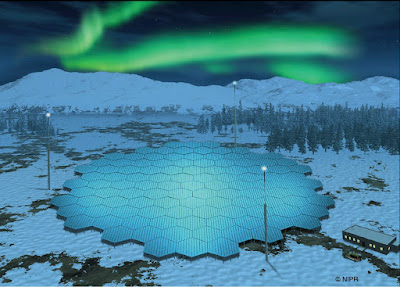 |
| Havainnekuva EISCAT_3D-lähettimestä. Antenniryhmät ovat kuusikulmaisia, niitä on 109 kappaletta, ja jokainen sisältää 91 antennielementtiä. Antennikentän halkaisija on n. 70 m. |
EISCAT_3D-tutkajärjestelmään kuuluu kolme asemaa Pohjois-Skandinaviassa: lähetin-vastaanotin Skibotnissa Norjassa sekä vastaanottimet lähellä Kaaresuvantoa Suomessa ja lähellä Kiirunaa Ruotsissa. Skibotnin suurteholähettimen teho on 5 MW ja kukin asema sisältää noin 10 000 antennia. Hankkeen kokonaisbudjetti on 70 miljoonaa euroa ja projekti alkaa syyskuun 2017 alussa. Asemien valmistelutyöt alkavat kesällä 2018 ja tutkajärjestelmän arvioidaan olevan käytössä vuonna 2021.
 |
| EISCAT_3D-tutkajärjestelmän asemien sijainnit kartalla: lähetin-vastaanotin Norjassa ja vastaanotinasemat Suomessa ja Ruotsissa. |
EISCAT_3D:n avulla voidaan tutkia sitä, miten avaruudesta peräisin olevat suurienergiset hiukkaset ja sähkövirrat vaikuttavat ilmakehän eri osissa, sekä avaruussäähäiriöiden vaikutusta teknologisiin järjestelmiin, kuten satelliitteihin, satelliittipaikannukseen ja sähkönjakeluverkkoihin. EISCAT_3D-tutkan avulla voidaan tutkia myös revontulia, jotka esiintyvät ylemmässä ilmakehässä noin sadan kilometrin korkeudella.
Tutkan rakentaa tieteellinen EISCAT-järjestö, jonka jäseniä ovat Norja, Ruotsi, Suomi, Iso-Britannia, Japani ja Kiina. EISCAT_3D:tä on suunniteltu useissa EU-rahoitteisissa projekteissa viimeisten kymmenen vuoden aikana. Suomen Akatemia rahoittaa investoinnista 12,8 miljoonaa euroa. Oulun yliopiston osuus on 756 000 euroa.
Suomessa EISCAT_3D-hanketta koordinoi Oulun yliopisto ja sen yhteydessä toimiva Sodankylän geofysiikan observatorio. Observatorion johtaja Esa Turunen toteaa, että nyt tehty rakentamispäätös on merkittävä kansainvälinen investointi Suomeen, Ruotsiin ja Norjaan seuraaviksi 30 vuodeksi. Investoinnin taloudelliset heijastusvaikutukset ovat moninkertaiset.
Oulun yliopiston avaruusfysiikan professori Anita Aikio kertoo, että hanke on tärkeä suomalaiselle korkeatasoiselle avaruustutkimukselle: ”Ensimmäistä kertaa voimme kolmiulotteisesti mitata avaruudesta tulevien hiukkasten ja sähkövirtojen vaikutusta ylä- ja keski-ilmakehään samanaikaisesti ja näin tutkia yhteyksiä avaruusfysiikan ja ilmakehäfysiikan välillä.”
Lisätietoja:
- Johtaja, FT Esa Turunen, Sodankylän geofysiikan observatorio, Oulun yliopisto, puh. 050 5663 264, sähköposti: esa.turunen (at) oulu.fi
- Professori Anita Aikio, Oulun yliopisto, puh. 050 3500 641, sähköposti: anita.aikio (at) oulu.fi
- Johtava tiedeasiantuntija Kati Sulonen, Suomen Akatemia, puh. 029 533 5110, sähköposti: kati.sulonen (at) aka.fi

